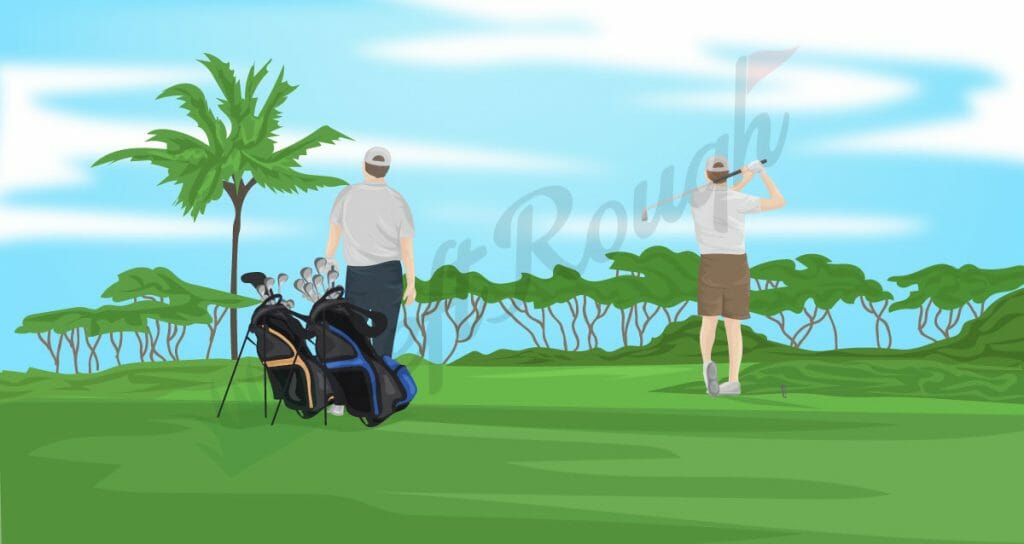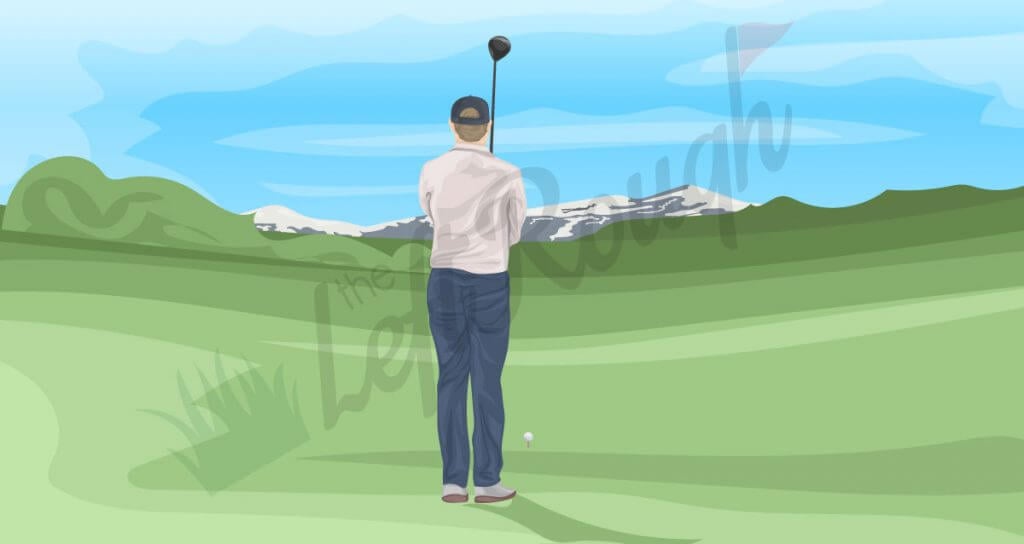A golf lay up is not quite as easy a layup in basketball. These shots are among the most difficult on the course.
Not to mention, on tee shots, you must decide if you should lay down or not. Luckily Shot Scope and other studies have made it clear if amateur golfers should or shouldn’t lay up. This article will show you how to improve your approach shots, and how to increase your chances of scoring a birdie.
Golf Laying Up
Lets start with what is laying up in the game of golf.
Laying up refers to avoiding a green intentionally. For example, let’s say you have 220 yards left for your second shot into a par 5. You realize that there are a lot of problems (like a water hazards) so you decide on a shorter club and then a wedge to the green.
Your second shot is your “lay up” as you hit a club that will leave you a good distance for your third shot. Golfers will aim to leave their shot at a fair distance to get a full club. Or, they can hit a club they feel comfortable hitting into the green.
Expanding on our example, let’s say you want to leave yourself with 100 yards to the hole. 220 – 100 = 120 so you want a club that goes about 120 yards for a good third shot.
The Key Takeaways
- Golf lay ups are a strategy that allows you to score lower by playing less aggressively.
- Laying up isn’t as good of a strategy as some might think depending on the lie, distance, and skill level.
- Laying up is the act of not trying to get on a hole in two or three shots, depending on the terrain.
Keep reading to learn when you should lay up and when statistically, it’s a bad strategy.
Approach Shot Strategy
If you’re like most golfers chances are you’ve asked, “Should you lay up in golf?”
It’s a great question because playing better golf often results from making better decisions. Old school golfers think it’s the right move for a lot of the time and is the “safer” play. Nevertheless, there is so much data available thanks to ShotLink and golf apps. This means that laying up might not be a good strategy.
Don’t get me wrong, traditional old-school golf advice makes sense. You can lay up to a distance so that you can hit the green from a distance that you like (typically a full SW or LW). But Golf.com and Golftec have debunked this theory. As did Shot Scope, so let’s see why a lay up shot might hurt your score.
Data on shot scoring for the average golfer
According to Shot Scope, “According to statistics, the average distance between a golfer and the hole is 64 feet. The average proximity from a 110y shot on the fairway is 64 ft, versus 35 ft from a 50y shot.”
Shot Scope found that laying up can lead to a loss of about half a shot per Par 5!
Why you should stop laying up
It is easy to see that the closer you are to the nearest approach shot from Tour level up to 100s. Case in point… 25 yards vs. 75 yards based on the stats collected in this Golf.com article.
80s Golfer
An 80s player will be able to average four feet from the hole at 25 yards. But from 75 yards (a “perfect” distance for a lot of players) the average is eight feet. This may not seem like a lot. But it is when you look at the averages of the greens on the PGA Tour.
The average PGA Tour make rate is 92% from four feet. While the eight-foot average is about 50% – you’re giving up about 40% chances of making the putt. This means that par 5s have more pars, and fewer birdies.
Don’t forget, par 5s might be the longest holes on the golf course but they’re also statistically the lowest scoring average. If you tee off too far, your chances of missing the green or making pars, bogeys or worse are higher.
Click here for more information about how to break 80.

90s Golfer
A 90s golfer will be able to average five feet from 25 yards. But from 75 yards, it’s closer to 10 feet. Once again, it doesn’t seem like a huge difference but it is when it comes to putting averages.
The worlds best players only make four out of five putts (50%) from five feet. This is a drastic drop from the average of 92%) at four feet. The make rate from 10 feet is less than 40%. These are the top players in the world. They have caddies who read putts on the best greens.
I can see a 90-year old golfer making a 10-footer. Its obvious that a closer approach shot results in a closer putt. Even if it’s not the “perfect distance” for your third shot, it’s usually the best course management strategy.
Click here to find out more about Breaking 90.
When to Lay Up
While the statistics show that laying up isn’t the best strategy a lot of times, there are some instances where you should.
If you don’t like hitting your 3-wood off the ground, it might not be the best option. You could end up hitting it over the green and then leave a very long third shot. Another instance might be if you’re in thick rough and hitting a hybrid or fairway wood can cause a big miss.

If there are many hazards in play (water or out of bounds), you might need to reduce your second shot. Although you should play more aggressively, you need to adjust your strategy if there are penalty strokes involved. This is why it’s so important to understand the hole by using a golf GPS or yardage book.
It is much easier to plan your approach shot strategy when you have a clear view of the hole. There’s nothing worse than hitting a good shot but seeing it go OB or in the water because you didn’t know it was there. So make sure you map out the hole on the tee box as part of your tee shot strategy to avoid wasting shots.
How to Hit Lay-Up Shots in Golf
Even though lay up shots should be as easy as a layup in basketball, it’s not always that simple.
Why?
Because a lot of golfers don’t focus on the shot as it’s “just a lay up shot.” This can lead to a lazy swing, not picking a target, and hitting your lay up in the rough and putting yourself out of position.
This is a common mistake. Follow the laid up rules below to avoid it.
Know Your Distances
Before selecting a club to hit your layup, it’s vital to know your distances for each club in the bag. If you don’t map out your distances, how will you know what is the “perfect” distance to lay up?
You should also know how far each wedge can be rolled comfortably. This will allow you to determine the distance you can comfortably lay your wedge to ensure a full swing wedge for your next shot.
Make sure to map out your distances with a launch monitor so you’re dialed in on the golf course. Click here to see the best launch monitors for golf.
Hit Your “Go-to Club”
To hit a good lay-up shot, the second step is to use a club that inspires confidence. If you’re trying to lay up with a hard to hit long iron, it likely won’t inspire a ton of good vibes over the ball.
Instead, hit a club that tends to work out well – whether it’s a hybrid, 7-wood, or driving iron. Try to get as close to the green as possible based on the stats from above (as long as you aren’t bringing unnecessary hazards into play).
Always choose a target
Once you have your club, it’s time to pick a target. This step is where most golfers become lazy and say something like “I’m just trying to hit up in the fairway.” But just like a tee shot, you need specifics!
Always pick something to aim at; whether it’s a zone between two trees or a small target. Then, pick your intermediary target so ensure you’re aligned properly once you’re over the ball.

Check out Your Pre-Shot Routine
Once you have a feeling-good target and a club, be sure to continue with your pre-shot routine. This is not the time to get lazy and “wing it.”
To get your body ready for the shot, practice 1-2 swings with 70-90% swing speed. Take a deep breathe and then step into the golf ball.
Click here to find out more about creating a consistent routine for pre-shots.
Aggressively swing
The final step in playing well is to play aggressively. Too many golfers try to “guide” these shots with a more controlled swing. However, this control often leads to a more uncommitted and slower swing.
While you don’t need to swing like a long drive champion, make sure you swing with your normal speed. These tips will hopefully help you hit the target and leave you with an easy next shot on the green.
FAQ
Are you looking for more information about course strategy and laying up? Continue reading to find out the most frequently asked questions.
What is a layup in golf?
Layup distance refers to trying to hit a shot from a distance that is good enough for your next shot.
For example, golfers tend to have a favorite distance and feel confident playing it. For me, it’s 75 yards or 100 yards as that is an easy lob wedge or a full sand wedge.
Once you have determined your ideal distance, subtract it from the total distance to reach the green. If you have 280 yards to the green and your ideal layup distance is 100, you will need to hit a 180-yard shot (280-1100).
Do I need to lay 100 yards?
In fact, the data above shows that the greener you are, the better. If there are hazards or fairway bunkers that might lead to big numbers from going for the green in two, a lay up is recommended.
What’s the best lay up distance?
The closest one to you is the best, but it doesnt matter which one you prefer.
You’re more likely to hit it closer from 50 yards vs. 75 yards vs. 100 yards. The closer you are to the hole, the more likely it is that you will make the putt and shoot lower scores.
This is why it’s so important to be strategic with lay up shots in golf. For a quick third, spend extra time on your second shot to calculate the best distance to hit your lay-up.
Make sure you’ve read our article on hitting the in-between wedge shot.
Final Thoughts about Par 5 Lay Ups
Players from the past always thought laying up was the “smart” move to find a perfect third shot distance. But with so much data about amateur and pro golfers, now it’s clear that it’s not the best play in a lot of cases.
In general, it’s best to get as close to the green as possible in regulation.
You can play better each round if you have a shorter shot. Hit driver off the tee, don’t hit the layup shot if you can go for it (and avoid a water hazard or fairway bunker) and you’re on your way to lower scores.
Don’t forget to hit the putting green too as you’ll likely have a lot more looks at birdie.
